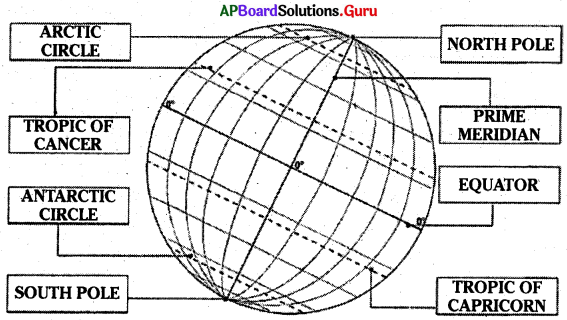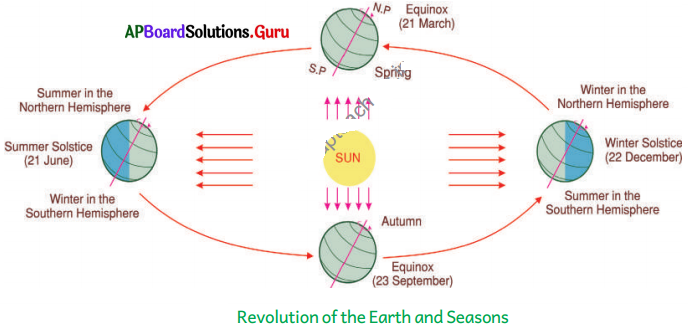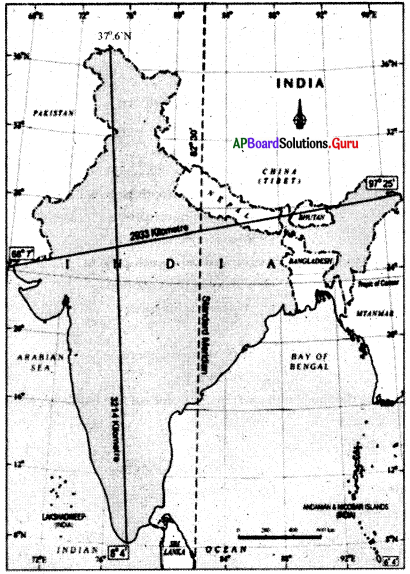These AP 6th Class Social Important Questions 2nd Lesson Globe – Model of the Earth will help students prepare well for the exams.
AP State Syllabus 6th Class Social Important Questions 2nd Lesson Globe – Model of the Earth
Question 1.
What is a Globe?
Answer:
Globe is an object shaped like a ball with a map of the world on its surface, usually on a stand so that it can be turned. It is a model of the Earth. It shows the shape of the earth, land, and water, the continents and oceans, and the main countries of the world.
Question 2.
When was the oldest terrestrial globe was made and by whom?
Answer:
The oldest terrestrial globe was made in 1492 by Martin Behaim.
![]()
Question 3.
What are the advantages of the globe?
Answer:
The globe is small in shape. It is convenient to carry and use, and depicts all features of the earth.
Question 4.
Does the Earth have a needle-like globe?
Answer:
No. The Earth doesn’t have a needle-like globe.
Question 5.
What is an axis?
Answer:
A needle fixed through the globe in a tilted manner is called the axis.
Question 6.
What is the Equator?
Answer:
The imaginary line that divides the globe into two spheres is called the Equator. It is 0° latitude.
Question 7.
What are latitudes?
Answer:
The imaginary lines that are drawn parallel to the Equator are called latitudes.
![]()
Question 8.
What are longitudes?
Answer:
The lines drawn perpendicular to latitudes on the globe are called Iogitudes. These longitudes connect the North pole and South pole.
Question 9.
Basing on the equator, how many spheres the Earth was divided into? What are they?
Answer:
Basing on the equator the Earth was divided into two equal spheres. They are Northern Hemisphere and Southern Hemisphere.
Northern hemisphere: The hemisphere that lies north of the equator is the Northern hemisphere.
Southern hemisphere: The hemisphere that lies south of the equator is the Southern hemisphere.
Question 10.
What are the important latitudes in the Northern hemisphere?
Answer:
North pole (90° N), The Arctic circle (66\(\frac{1}{2}\)° N), the Tropic of Cancer (23\(\frac{1}{2}\)° N) are the important latitudes in the Northern hemisphere.
Question 11.
What are the important latitudes in the Southern hemisphere?
Answer:
South pole (90°S), The Antarctic circle (66\(\frac{1}{2}\)°S), the Tropic of Capricorn (23\(\frac{1}{2}\)°S) are the important latitudes in the Southern hemisphere.
![]()
Question 12.
Basing on prime meridian into how many spheres the Earth was divided? What are they?
Answer:
Basing on the prime meridian the Earth was divided into two equal spheres. They are Eastern Hemisphere and Western Hemisphere.
Eastern hemisphere: The hemisphere that lies east of the prime meridian is the Eastern hemisphere.
Western hemisphere: The hemisphere that lies west to the prime meridian is the West¬ern hemisphere.
Question 13.
What are the two types of lines needed to locate any point on the earth’s surface?
Answer:
Latitudes and longitudes are required to locate any point on the earth’s surface.
Question 14.
What is the earth’s rotation?
Answer:
Earth spins on its own axis from west to east. This movement is called rotation.
Question 15.
How the day and night are caused?
Answer:
Day and night are caused due to earth’s rotation. While the earth is moving on its own axis half of the earth receives Sun’s rays. It is a day for that part of the Earth. The other half of the earth will remain in dark. It is a night for that part of the earth.
Question 16.
How much time it will take for a rotation of Earth?
Answer:
For one rotation of the earth, it takes 23 hours 56 minutes and 4.09 seconds.
![]()
Question 17.
What is called revolution? How many days it will take for one revolution?
Answer:
While moving on its own axis earth also moves around the Sun. This movement is called revolution. It will take 36554 days for one revolution.
Question 18.
How do the seasons change in the Northern and Southern hemispheres?
Answer:
When the Northern Hemisphere is oriented toward the sun, that region of Earth warms because the sun’s rays fall on that part of the Earth at a more direct angle. It’s summer in Northern Hemisphere.
When the Northern Hemisphere is oriented away from the sun, the sun’s rays are: less direct, and that part of Earth cools. It’s winter in Northern Hemisphere.
Seasons in the Southern Hemisphere occur at opposite times of the year from those in the Northern Hemisphere. Northern summer = Southern winter. Northern winter = Southern summer:
Question 19.
How many days a normal year has?
Answer:
A normal year consists of 365 days.
Question 20.
What is a leap year?
Answer:
A year which consists of 366 days instead of 365 days is called a leap year. Usually, a year consists of 365 days. In a leap year, we have 29 days in February, unlike 28 days. For every four years, a leap year will come.
Question 21.
What is the summer solstice?
Answer:
The day when the Earth’s North Pole is tilted closest to the Sun is called the summer solstice. The summer solstice marks the longest day and shortest night of the year. This happens on June 21st.
![]()
Question 22.
What is the winter solstice?
Answer:
The day when the Earth’s North Pole is tilted farthest to the Sun is called the winter solstice. The winter solstice marks the longest night and shortest day of the year. This happens on December 22nd.
Question 23.
What is an Equinox?
Answer:
The day when neither the North pole nor the South pole tilted towards the Sun is called Equinox. On this day direct rays of the Sun fall on the Equator. So, the whole earth experiences equal day and night. So, it is called an Equinox. This happens on 21st March and 23rd September.
Question 24.
When does an Eclipse happen?
Answer:
We know that Earth revolves around the Sun and Moon revolves around the Earth. Sometimes while revolving, the Sun, the Moon, and the Earth come into a straight line. At that time an eclipse occurs. During the time of eclipses, it appears that a shadow is cast either on the Sun or on the Moon.
Question 25.
When does a Solar Eclipse occur?
Answer:
A solar eclipse occurs when the Moon passes in a direct line between the Earth and the Sun. The Moon’s shadow travels over the Earth’s surface and blocks out the Sun’s light as seen from Earth. A solar eclipse occurs only on new moon day. But not on all new moon days.
Question 26.
When does a lunar eclipse occur?
Answer:
A lunar eclipse occurs when the Moon passes directly behind Earth and into its shadow, This can occur only when the Sun, Earth, and Moon are exactly or very closely aligned With Earth between the other two. During a toted lunar eclipse, Earth completely blocks direct sunlight from reaching the Moon. Lunar eclipses occur only on a full moon day. But lunar eclipse does not occur on all full moon days.
![]()
Question 27.
Which eclipse occurs commonly?
Answer:
A lunar eclipse occurs commonly than a Solar eclipse.
Question 28.
Illustrate the position of the Sun, the Earth, and the Moon during each Eclipse by usingS I M I E. Explain how their positions differ.
Answer:

- The Earth revolves around the Sun and the moon revolves around the Earth. Sometimes while revolving, the Sun, the Moon, and the Earth come into a straight line. At that time an eclipse occurs.
- If the moon comes in between the Sun and the Earth a Solar eclipse occurs.
- If the Earth comes in between the Sun and the Moon a Lunar eclipse occurs.
Question 29.
Write the names of imaginary lines on the Earth in their respective box:
Answer:
Tropic of Cancer, Tropic of Capricorn, Equator, North Pole South Pole, Prrfhelongitude, Arctic Circle, Antarctic Circle.

![]()
Question 30.
In Australia, Christmas is being celebrated In summer. Why?
Answer:
Australia is located in the Southern Hemisphere. On 22nd December, the Tropic of Capricorn receives direct rays of the Sun as the South Pole tilts towards the Sun. As the Sun rays fall vertically at the Tropic of Capricorn, a larger portion of the Southern Hemisphere gets light. So, it is summer in the Southern Hemisphere. As Christmas is celebrated on December 25 it is summer in Australia.
Question 31.
If the rotation of the earth stops, what will happen?
Answer:
Because of rotation we experience day and night. If the earth doesn’t rotate there would be no day and night. The eastern hemisphere is always in the day and the western hemisphere is always in the night. The eastern hemisphere is hot as it experiences always day and cold in the western hemisphere. So it would make the planet uninhabitable.
Question 32.
How do seasons occur?
Answer:
The Earth’s movement around the sun causes seasons. During this movement, if the earth leans towards the sun summer happens. It earth leans away from the sun winter happens. In between spring and Autumn occurs.
Question 33.
How do Eclipses form?
Answer:
Earth revolves round the Sun.
The moon revolves round the Earth.
While they revolve, they come in a straight line for some time.
Either solar eclipse or lunar eclipse occurs.
![]()
Question 34.
Globe has a history. Explain in brief.
Answer:
- Globe is the model of the Earth. It is derived from the Latin word “Globus”.
- The oldest terrestrial globe was made by Martin Behaim in 1492.
- Modern looking terrestrial globe was made by Taqi AI-Din during 1950s.
- The first seamless celestial globe was made by Moghal scientists in the Jahangir period.
Question 35.
The Indian Map given below identify the latitudes and longitude of the given states.

- Andhra Pradesh
- Karnataka
- Jharkhand
- Telangana
- Uttarakhand
- Himachal Pradesh
- Gujarat
- Assom
- Madhya Pradesh
Answer:
| State | Latitudes | Longitudes |
| Andhra Pradesh | 12°41′ – 19°07′ N | 77° – 84°40′ E |
| Karnataka | 11°30′ – 18°30’ N | 74° – 78°30′ E |
| Jharkhand | 21°87′ – 25°4′ N | 83°28′ – 88°02′ E |
| Telangana | 15°46′ -19°47′ N | 77°16′ – 81°43’E |
| Uttarakhand | 28°44’ – 31°28′ N | 77°35′ – 81°0r E |
| Himachal Pradesh | 30°22′ – 33°12’N | 75°45‘ – 79°04’ E |
| Gujarat | 20°06′ – 24°42′ N | 68°10′ – 74°28’E |
| Assom | 22°19′ – 28°16’N | 89°42′ – 96°30′ E |
| Madhya Pradesh | 21 °6′ – 26°3Q’ N | 74°9’ – 82°48′ E |
![]()
Question 36.
What are the important longitudes on the globe?
Answer:
- 0° longitude is called Prime Meridian.
- 180° Greenwich longitude is called the International dateline.
Question 37.
Read the given picture “Revolution of the Earth and seasons and analyze it.

Answer:
- The picture indicates the Earth’s revolution around Sun.
- The fixed orbit of the Earth is elliptical in shape.
- Day and Night are equal (Equinox) on 21st March and 23rd September.
- Seasons occur due to Earth’s revolution.
- Seasons are not common for the whole earth, but it differs between Hemispheres.
Question 38.
Name the countries to spread both the Hemisphere.
Answer:
Countries spread both in Northern & Southern Hemisphere
- Ecuador
- Colombia
- Brazil
- Gabon
- Congo
- the Congo Republic
- Uganda
- Kenya
- Indonesia
B. Countries spread both in Northern & Southern Hemisphere.
- U.K.
- France
- Spain
- Argentina
- Mali
- Ghana
- Togo
- Burkina Faso
![]()
Question 39.
Give an example of your personal experience on the rotation of the earth.
Answer:
- Most of the important Games & Sports events were held at night.
- It is clarified by studying the rotation of the earth that those places are in the Western Hemisphere.
- The people in Western Hemisphere may also feel the same when the games are held in Eastern Hemisphere.
Question 40.
Appreciate the wonders of rotation and revolution.
Answer:
- One must appreciate scientists for finding facts on earth.
- Earth’s rotation continuously without an axis is nature’s magic.
- Earth revolution on fixed orbit for a long & limitless time without any road/way.
Question 41.
Point out the starting & ending points of latitudes and longitudes of India in the India map.
Answer:

